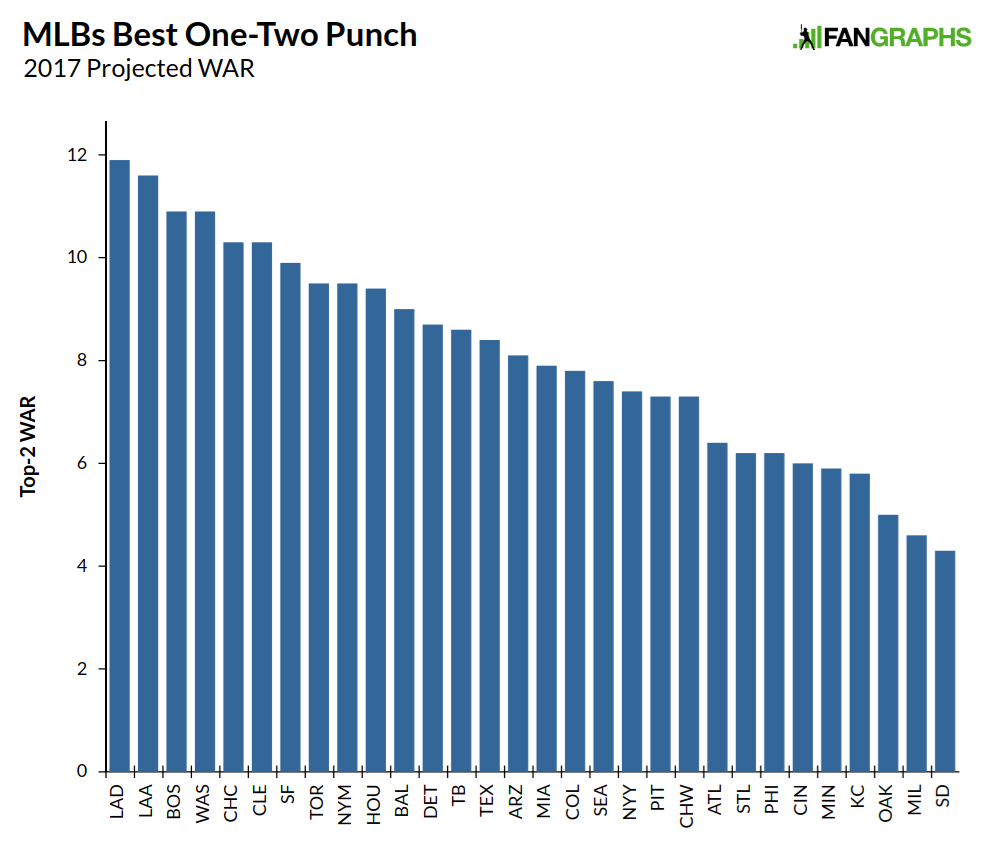2017 Positional Power Rankings: Bullpen (#16-30)
The positional power rankings continue. If you’ve come across the 16th- through 30th-ranked bullpens by accident or are otherwise unfamiliar with these power rankings, feel free to read Dave Cameron’s introduction. If you’re interested in any other positional rankings, use the links above this paragraph. For the start of the relief-pitcher portion, read on.
The graph below contains half the major-league teams. If you don’t see your favorite team below, congratulations: you cheer for a club that ranks in the top half of baseball when it comes to relievers. Those teams will be covered in short order, and if there’s a link at the beginning of this post to them, that means they’ve already been published.

While this post covers the bottom half of the rankings, the first few teams included here are extremely close to the teams just ahead of them, and there are a few bullpens whose projections potentially underrate them. Add in some reliever volatility and random fluctuation, and we could see a number of these clubs among the league’s top 10 at the end of the year.
A note: while you won’t find Andrew Miller’s club here, you’ll find his name invoked with some frequency. There’s been a lot of talk in recent years about deploying elite relievers in non-traditional but high-leverage situations. Cleveland’s use of Andrew Miller in last year’s postseason is about the purest expression of this concept in some time. While that sort of usage isn’t sustainable over the course of a full regular season, there are times when it represents the best option for a team.
To that end, I’ve provided a rating (out of 10) of every team’s capacity to use a reliever in these non-traditional situation. I refer to this as the Andrew Miller Situation Scale. The ratings are subjective and somewhat arbitrary, but tend to be higher for clubs whose best reliever isn’t also their closer. Secondary considerations include the club’s motivations for using the strategy (if it’s financially motivated, for example) as well as the actual quality of both the “elite” reliever and closer. Basically, the higher the number, the more the situation resembles an Andrew Miller situation.
| Name | IP | K/9 | BB/9 | HR/9 | BABIP | LOB% | ERA | FIP | WAR |
|---|---|---|---|---|---|---|---|---|---|
| Roberto Osuna |
65.0 | 10.3 | 2.3 | 1.1 | .297 | 77.8 % | 3.13 | 3.34 | 1.5 |
| Jason Grilli | 65.0 | 10.9 | 3.8 | 1.3 | .305 | 76.4 % | 3.82 | 3.92 | 0.6 |
| Joseph Biagini | 55.0 | 8.0 | 2.8 | 1.0 | .314 | 73.4 % | 3.89 | 3.96 | 0.4 |
| J.P. Howell | 55.0 | 7.4 | 3.4 | 0.9 | .316 | 74.0 % | 3.90 | 4.04 | 0.2 |
| Joe Smith | 45.0 | 7.8 | 2.9 | 1.0 | .306 | 73.9 % | 3.77 | 4.07 | 0.2 |
| Aaron Loup | 40.0 | 8.6 | 3.1 | 1.0 | .309 | 74.1 % | 3.76 | 3.94 | 0.2 |
| Ryan Tepera | 35.0 | 8.7 | 3.5 | 1.1 | .309 | 73.8 % | 3.99 | 4.13 | 0.0 |
| Danny Barnes | 30.0 | 9.8 | 2.4 | 1.1 | .311 | 74.3 % | 3.63 | 3.55 | 0.2 |
| Christopher Smith | 25.0 | 8.3 | 4.2 | 1.3 | .324 | 69.1 % | 5.10 | 4.74 | 0.0 |
| Bo Schultz | 20.0 | 6.9 | 3.1 | 1.3 | .305 | 70.5 % | 4.57 | 4.54 | 0.0 |
| Matt Dermody | 15.0 | 6.5 | 2.5 | 1.2 | .313 | 69.1 % | 4.59 | 4.37 | 0.0 |
| Mat Latos | 10.0 | 6.6 | 3.0 | 1.3 | .309 | 70.2 % | 4.77 | 4.69 | 0.0 |
| Glenn Sparkman |
10.0 | 7.6 | 2.5 | 1.4 | .312 | 71.1 % | 4.47 | 4.43 | 0.0 |
| The Others | 15.0 | 8.3 | 4.2 | 1.3 | .324 | 69.1 % | 5.10 | 4.74 | 0.0 |
| Total | 485.0 | 8.7 | 3.1 | 1.1 | .310 | 73.7 % | 3.93 | 4.00 | 3.3 |
The list of relief pitchers with a better projection than Roberto Osuna isn’t long. None of the other pitchers I’m covering today are superior, in fact, and he ranks 10th overall. Osuna is just 22 years old and is entering his third MLB season. He struck out nearly 30% of batters and walked just 5% last season, and led American League relievers with a 21% infield-fly rate. The Blue Jays rank this low not because of Osuna, but because of the rest of the pen.


 Last season was marked by a surge of offense throughout baseball, and this was very much the case for second basemen, who posted one of the
Last season was marked by a surge of offense throughout baseball, and this was very much the case for second basemen, who posted one of the 


